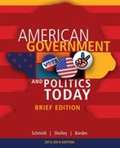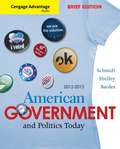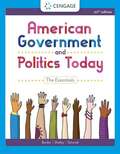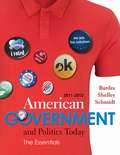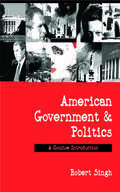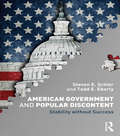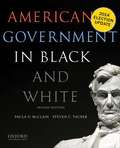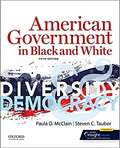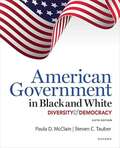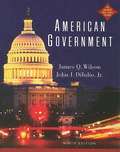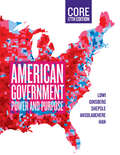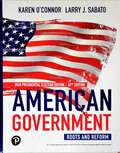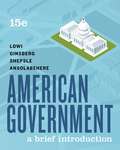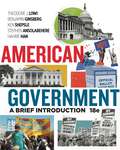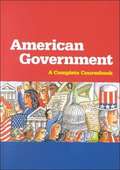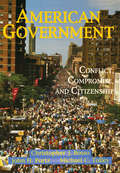- Table View
- List View
American Government and Politics Today 2014-2015 Brief
by Steffen W. Schmidt Mack C. Shelley Barbara A. BardesThe text works to show how easily and effectively readers can participate in the political process. Praised for its balanced coverage, the book examines all the key concepts of American government, while providing exciting features that focus on active citizenship.
American Government and Politics Today, 2008-2009 Brief Edition
by Steffen W. Schmidt Mack C. Shelley Barbara A. BardesWith new engaging features and as part of the Wadsworth Advantage Series, AMERICAN GOVERNMENT AND POLITICS TODAY: BRIEF EDITION, 2008-2009 highlights today's controversial issues and shows how you can become involved in American government and make a difference as an active, informed citizen. Praised for its balanced and up-to-the-minute coverage, this book focuses on the fundamentals -- the constitutional, governmental, political, social, and economic structures and processes that are the core of American government. The text also includes coverage of policy and analysis issues.
American Government and Politics Today, Brief Edition, 2012-2013
by Steffen W. Schmidt Mack C. Shelley Barbara A. BardesThe text works to show how easily and effectively readers can participate in the political process. Praised for its balanced coverage, the book examines all the key concepts of American government, while providing exciting features that focus on active citizenship.
American Government and Politics Today: The Essentials
by Steffen W. Schmidt Barbara A. Bardes Mack C. Shelley IIBardes/Shelley/Schmidt's AMERICAN GOVERNMENT AND POLITICS TODAY, THE ESSENTIALS, 20th Edition, equips you with the tools and knowledge you need to become an active, informed participant in the U.S. political process. <p><p>Making politics personal, it focuses on how government impacts you—now and in the future. Unbiased, concisely organized and updated with 2020 election analysis, it delivers thorough coverage in a streamlined, easy-to-read format. Emphasizing critical thinking about political issues, it encourages you to become involved in the political process. Current, compelling and thought-provoking examples offer insight into such pressing issues as the global COVID-19 pandemic, racial injustice, police brutality, economic inequality and more.
American Government and Politics Today: The Essentials (2011-2012 Edition)
by Steffen W. Schmidt Mack C. Shelley Barbara A. BardesThe 2011--2012 edition of American Government and Politics Today: The Essentials contains many pedagogical aids and high-interest features to assist both students and instructors. Some of the features are: The Politics of Boom and Bust; What If?; Margin Definitions; Did You Know?; Which Side Are You On?; Questions for Discussion and Analysis; Key Terms; Chapter Summary; Selected Print and Media Resources; E-mocracy, and many more.
American Government and Politics in the Information Age
by David L. Paletz Diana Owen Timothy E. CookAmerican Government and Politics in the Information Age by Paletz, Owen, and Cook, is a comprehensive introduction to the vital subject of American government and politics. It is a comprehensive introduction to American politics and government; it covers all the basics. The text: * introduces the intricacies of the Constitution, the complexities of federalism, the meanings of civil liberties, and the conflicts over civil rights; * explains how people are socialized to politics, acquire and express opinions, and participate in political life; * describes interest groups, political parties, and elections--the intermediaries that link people to government and politics; * details the branches of government and how they operate; * shows how policies are made and affect people's lives.
American Government and Politics in the New Millennium, Ninth Edition
by Virginia Stowitts Traina Karen Sunshine Christine SchultzPolitical Science textbook for Undergraduates.
American Government and Politics: A Concise Introduction
by Dr Robert P. SinghAmerican Government and Politics is a completely new introductory textbook designed and written for all students of politics coming to the subject for the first time. It provides a lively and accessible introduction and guide to all the main features and characteristics of one of the most distinctive and complex contemporary political systems in the world. From the impeachment of Bill Clinton, to the controversy surrounding the 2000 presidential election, and the Bush administration's responses to September 11, students will gain a balanced and critical understanding of all the key issues and debates in contemporary American government and politics today. A number of key underlying themes include: - the nature of American values and identity - the influence of the constitution on political development - the ways in which key governing institutions function to produce domestic and foreign policy. Key features include: - comprehensive glossary of key terms - discussion and summary boxes - web links and guides to further reading Robert Singh is a lecturer in politics at Birkbeck College, London. American Government and Politics: A Concise Introduction is the foundation companion text to Contemporary American Politics: Issues and Controversies also published by SAGE. `Rob Singh has written a finely organized and informative textbook that combines to an unusually high degree analytical clarity, accessibility of style and form, and an enlightened scepticism about received wisdom. This is an admirable book' - Nigel Bowles, St Anne's College, Oxford `Full of topical information and written with sparkling clarity, this book is a short-cut to excellence for the discriminating student' - Rhodri Jeffreys-Jones, Professor of American History, University of Edinburgh `In American Government and Politics Robert Singh provides an excellent introduction to the subject. His approach is wide ranging, his examples well selected and his style is accessible. It will make an ideal book for introductory and more advanced university courses on US government. I strongly recommend the book to teachers and students' - Desmond King, Mellon Professor of American Government, University of Oxford `This is a well written and lively book that is an important addition to the ranks of textbooks on American politics. One of its many virtues is its recognition that the textbook today is useful to a student only if it links to the world of web-based resources. Highly recommended' - Alan Ware, Worcester College, Oxford
American Government and Popular Discontent: Stability without Success
by Steven E. Schier Todd E. EberlyPopular distrust and the entrenchment of government by professionals lie at the root of America’s most pressing political problems. How did U.S. politics get to this point? Contemporary American politics got much of its shape from the transformations brought about from the 1950s to the 1980s. Presidential and congressional behavior, voting behavior, public opinion, public policy and federalism were all reconfigured during that time and many of those changes persist to this day and structure the political environment in the early twenty-first century. Throughout American history, parties have been a reliable instrument for translating majority preferences into public policy. From the 1950s to the 1980s, a gradual antiparty realignment, alongside the growth of professional government, produced a new American political system of remarkable durability – and remarkable dysfunction. It is a system that is paradoxically stable despite witnessing frequent shifts in party control of the institutions of government at the state and national level. Schier and Eberly's system-level view of American politics demonstrates the disconnect between an increasingly polarized and partisan elite and an increasingly disaffected mass public.
American Government in Black and White (Second Edition)
by Paula D. Mcclain Steven C. TauberConcise, affordable, and engaging, American Government in Black and White, Second Edition, 2014 Election Update, is a unique introduction to American government that uses racial and ethnic equality as its underlying theme. Authors Paula D. McClain and Steven C. Tauber address issues of inequality in major facets of government, including the U. S. Constitution, key American political institutions and instruments of political behavior, and the making of public policy. Engaging the original voices of racial and ethnic actors in our nation's history, they show students how to measure and evaluate the importance of equality in America, from its founding up to today. FEATURES * Three kinds of text boxes that help students develop empirical and qualitative analytical abilities: "Measuring Equality," "Evaluating Equality," and "Our Voices" * Vignettes, illustrations, and case material that connect America's past and present * Running glossary definitions, thematic chapter conclusions, probing review questions, and annotated additional readings highlighting writings by and about racial and ethnic minorities
American Government in Black and White: Diversity and Democracy
by Steven C. Tauber Paula D. McClainAmerican Government in Black and White: Diversity and Democracy, Fifth Edition, covers the standard topics found in an Introduction to American Government text while also speaking to today's students who want to examine how racial inequality has shaped--and will continue to shape--who we are and what we believe. Authors Paula D. McClain and Steven C. Tauber address issues of inequality in American government, including the U.S. Constitution, key political institutions, the making of public policy while showing how to measure and evaluate the importance of equality in America, from its founding up to today.
American Government in Black and White: Diversity and Democracy
by Paula McClain Steven TauberAmerican Government in Black and White: Diversity and Democracy, Sixth Edition, covers the standard topics found in an Introduction to American Government text while also speaking to today's students who want to examine how racial inequality has shaped--and will continue to shape--who we are and what we believe. Authors Paula D. McClain and Steven C. Tauber address issues of inequality in American government, including the U.S. Constitution, key political institutions, the making of public policy while showing how to measure and evaluate the importance of equality in America, from its founding up to today.
American Government in Christian Perspective (2nd edition)
by Michael R. Lowman William R. Bowen George T. Thompson George C. CochranThe United States is just a little over 200 years old, a mere child in relation to the 6,000 years of recorded human history. Yet, in just two centuries, the United States has excelled the world's most ancient civilizations to become the greatest nation on earth.
American Government in Christian Perspective Third edition
by Michael R. Lowman William R. Bowen George T. Thompson George C. CochranChristian textbook
American Government, AP Version (9th Edition)
by James Q. Wilson John J. Dilulio Jr.For this edition we have included a new feature: Each chapter now ends with a section called "Reconsidering the Enduring Questions" that gives contemporary responses to the Enduring Questions with which each chapter begins. These brief essays should help students focus in a novel way on what many people think are the perennial puzzles of American politics.
American Government, Core (Seventeenth Core Edition): Power And Purpose
by Benjamin Ginsberg Theodore J. Lowi Stephen Ansolabehere Kenneth A. Shepsle Hahrie HanThe gold standard analytical approach reinvigorated A dynamic authorial team of leading American politics scholars and a teachable Five Principles of Politics framework made American Government: Power and Purpose the gold standard in its field for more than 30 years. The Seventeenth Edition introduces the first new co-author in a decade, Hahrie Han (Johns Hopkins University), who brings a contemporary perspective on teaching American government and on the foundational collective action principle interwoven throughout the text. Together with InQuizitive, Norton’s online learning tool, and the new Norton Illumine Ebook, American Government engages students in applying the Five Principles framework to American politics. In the process, they learn to think critically about course concepts and understand how contemporary scholarship shapes our understanding of American government, past and present. This purchase offers access to the digital ebook only.
American Government, Roots and Reform, 2020 Presidential Election Edition
by Karen O'Connor Larry J. SabatoAmerican Government, Roots and Reform, 2020 Presidential Election Edition, Fourteenth Edition, AP edition
American Government: A Brief Introduction
by Benjamin Ginsberg Stephen Ansolabehere Theodore J. Lowi Kenneth A. ShepsleWhy does the American political system work the way it does? This major revision brings a renewed focus to the institutions, processes, and data that illuminate big questions about governance and representation in the United States. With a new adaptive learning tool, this edition does more than ever to help students understand how American government developed over time and how it works today.
American Government: A Brief Introduction (Eighteenth Edition)
by Benjamin Ginsberg Theodore J. Lowi Stephen Ansolabehere Kenneth A. Shepsle Hahrie HanNew case-study framework brings American government to life. In the Eighteenth Edition, co-author Hahrie Han introduces an innovative new case-study framework that helps students see their own significance in the political system. Each chapter opens with a real-life example of a person whose engagement with government provides insights on a key question: If, when, and how do people matter in the American political system? The case is then woven through the chapter to introduce key concepts, and help students understand the significance of how the American political system affects our lives. Additional features and pedagogy in the Norton Illumine Ebook help students make sense of data—a long-standing hallmark of the book—and see how they can use evidence to answer questions about American government. This purchase offers access to the digital ebook only.
American Government: A Complete Coursebook
by Ethel Wood Stephen C. SansoneTextbook on recent American government events including William Jefferson Clinton's impeachment trial, the Presidential election of 2000, campaign finance reform, and the Microsoft anti-trust case.
American Government: Brief Version (8th edition)
by James Q. WilsonThe president gets elected because of some slick television ads, although he has ducked all the tough questions. His party's platform is a meaningless set of words that gives you no idea what he will do in office. Once in the White House. He proposes bill and then Congress decides which to pass.
American Government: Citizenship and Power
by Christine Barbour Gerald C. WrightNIMAC-sourced textbook
American Government: Citizenship and Power
by Christine Barbour Gerald C. WrightNIMAC-sourced textbook
American Government: Conflict, Compromise, And Citizenship
by Christopher J BossoWoven through this text is the unifying theme that American politics represents ?conflict and compromise,? in direct opposition to the increasingly commonly held view that all politics are dirty and all politicians are crooks. By presenting a balance of essential factual content with a broad assessment of system dynamics and their policy effects, the authors provide an accessible yet sophisticated overview of American politics.Features: Coherent theme of ?conflict versus compromise? in the American political system Consistent examination of American history for institutional development Emphasis on the positive role of citizenship in shaping good government Each chapter is accompanied by primary source readings Concise 12 chapter format Our computerized test bank is available for PC based Windows operating systems. Over 1000 test items (including multiple choice, true-false, short answer and essay questions) are offered via the ESATEST 2000 system. This system includes numerous options for creating and editing tests, options for creating multiple versions of a single test, and allows professors to administer tests via LAN or Web-based testing centers. A simple, user-friendly interface, along with animated program guides add to the program's ease of use.
American Government: Constitutional Democracy Under Pressure
by Cal JillsonAmerican Government: Constitutional Democracy Under Pressure highlights the necessary tension between our constitutional principles and institutions and the populist heat that sometimes roils our national politics, especially at the current political moment. Our constitutional democracy has been under pressure for some time, but few would deny that fears for its fate have deepened in just the past few years. We assume that our political institutions will limit and contain contemporary populism, just as the Founders intended and as they have in the past, but will they? An increasingly polarized electorate, urging their representatives to fight and never to compromise, may be stressing Constitutional limits. This new, compact core text offers to help American government teachers lead their students to a nuanced theoretical and practical understanding of what is happening in the politics of their Constitutional democracy today. A new, brief American government text that is compact yet comprehensive. The "Constitutional Democracy Under Pressure" theme is timely and provocative. Puts contemporary trends toward polarization and populism in context.
